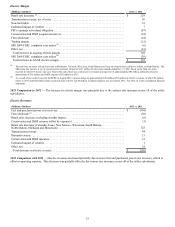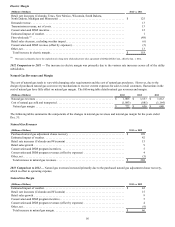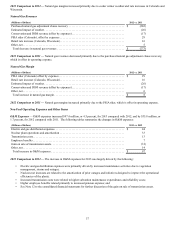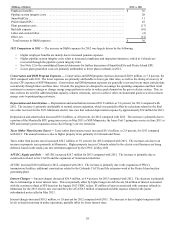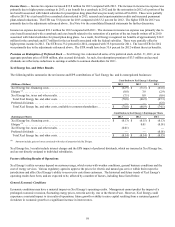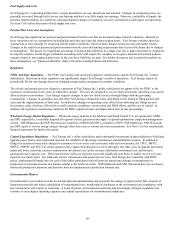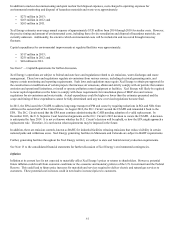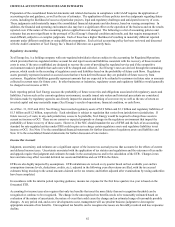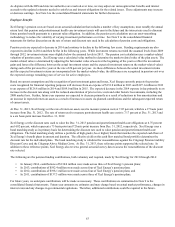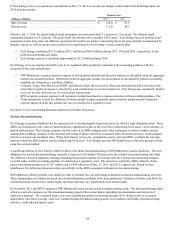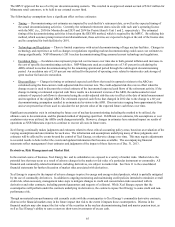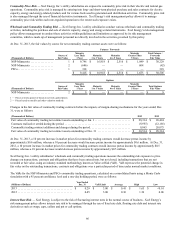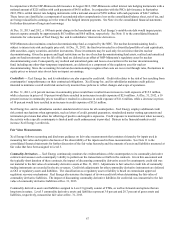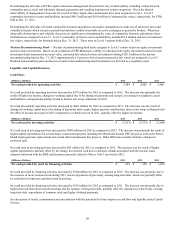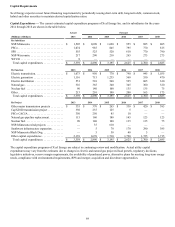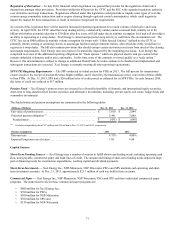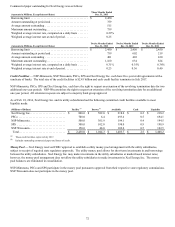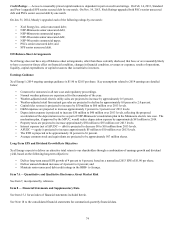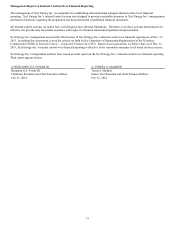Xcel Energy 2013 Annual Report Download - page 83
Download and view the complete annual report
Please find page 83 of the 2013 Xcel Energy annual report below. You can navigate through the pages in the report by either clicking on the pages listed below, or by using the keyword search tool below to find specific information within the annual report.
65
The MPUC approved the use of a 60-year decommissioning scenario. This resulted in an approved annual accrual of $14.2 million for
Minnesota retail customers, to be held in our external escrow fund.
The following key assumptions have a significant effect on these estimates:
• Timing — Decommissioning cost estimates are impacted by each facility’s retirement date, as well as the expected timing of
the actual decommissioning activities. Currently, the estimated retirement dates coincide with each unit’s operating license
with the NRC (i.e., 2030 for Monticello and 2033 and 2034 for Prairie Island’s Unit 1 and 2, respectively). The estimated
timing of the decommissioning activities is based upon the DECON method, which is required by the MPUC. By utilizing this
method, which assumes prompt removal and dismantlement, these activities are expected to begin at the end of the license date
and be completed for both facilities by 2091.
• Technology and Regulation — There is limited experience with actual decommissioning of large nuclear facilities. Changes in
technology and experience as well as changes in regulations regarding nuclear decommissioning could cause cost estimates to
change significantly. NSP-Minnesota’s 2011 nuclear decommissioning filing assumed current technology and regulations.
• Escalation Rates — Escalation rates represent projected cost increases over time due to both general inflation and increases in
the cost of specific decommissioning activities. NSP-Minnesota used an escalation rate of 3.63 percent in calculating the
AROs related to nuclear decommissioning for the remaining operational period through the radiological decommissioning
period. An escalation rate of 2.63 percent was utilized for the period of operating costs related to interim dry cask storage of
spent nuclear fuel and site restoration.
• Discount Rates — Changes in timing or estimated expected cash flows that result in upward revisions to the ARO are
calculated using the then-current credit-adjusted risk-free interest rate. The credit-adjusted risk-free rate in effect when the
change occurs is used to discount the revised estimate of the incremental expected cash flows of the retirement activity. If the
change in timing or estimated expected cash flows results in a downward revision of the ARO, the undiscounted revised
estimate of expected cash flows is discounted using the credit-adjusted risk-free rate in effect at the date of initial measurement
and recognition of the original ARO. The estimated expected cash flows that changed in 2012 due to the change to a 60 year
decommissioning assumption resulted in an immaterial revision to the ARO. Discount rates ranging from approximately four
and seven percent have been used to calculate the net present value of the expected future cash flows over time.
Significant uncertainties exist in estimating the future cost of nuclear decommissioning including the method to be utilized, the
ultimate costs to decommission, and the planned method of disposing spent fuel. If different cost estimates, life assumptions or cost
escalation rates were utilized, the AROs could change materially. However, changes in estimates have minimal impact on results of
operations as NSP-Minnesota expects to continue to recover all costs in future rates.
Xcel Energy continually makes judgments and estimates related to these critical accounting policy areas, based on an evaluation of the
varying assumptions and uncertainties for each area. The information and assumptions underlying many of these judgments and
estimates will be affected by events beyond the control of Xcel Energy, or otherwise change over time. This may require adjustments
to recorded results to better reflect the events and updated information that becomes available. The accompanying financial
statements reflect management’s best estimates and judgments of the impact of these factors as of Dec. 31, 2013.
Derivatives, Risk Management and Market Risk
In the normal course of business, Xcel Energy Inc. and its subsidiaries are exposed to a variety of market risks. Market risk is the
potential loss that may occur as a result of adverse changes in the market or fair value of a particular instrument or commodity. All
financial and commodity-related instruments, including derivatives, are subject to market risk. See Note 11 to the consolidated
financial statements for further discussion of market risks associated with derivatives.
Xcel Energy is exposed to the impact of adverse changes in price for energy and energy-related products, which is partially mitigated
by the use of commodity derivatives. In addition to ongoing monitoring and maintaining credit policies intended to minimize overall
credit risk, when necessary, management takes steps to mitigate changes in credit and concentration risks associated with its
derivatives and other contracts, including parental guarantees and requests of collateral. While Xcel Energy expects that the
counterparties will perform under the contracts underlying its derivatives, the contracts expose Xcel Energy to some credit and non-
performance risk.
Though no material non-performance risk currently exists with the counterparties to Xcel Energy’s commodity derivative contracts,
distress in the financial markets may in the future impact that risk to the extent it impacts those counterparties. Distress in the
financial markets may also impact the fair value of the securities in the nuclear decommissioning fund and master pension trust, as
well as Xcel Energy’s ability to earn a return on short-term investments of excess cash.


